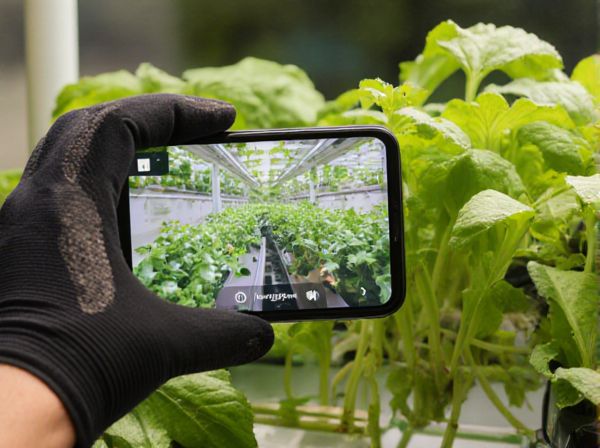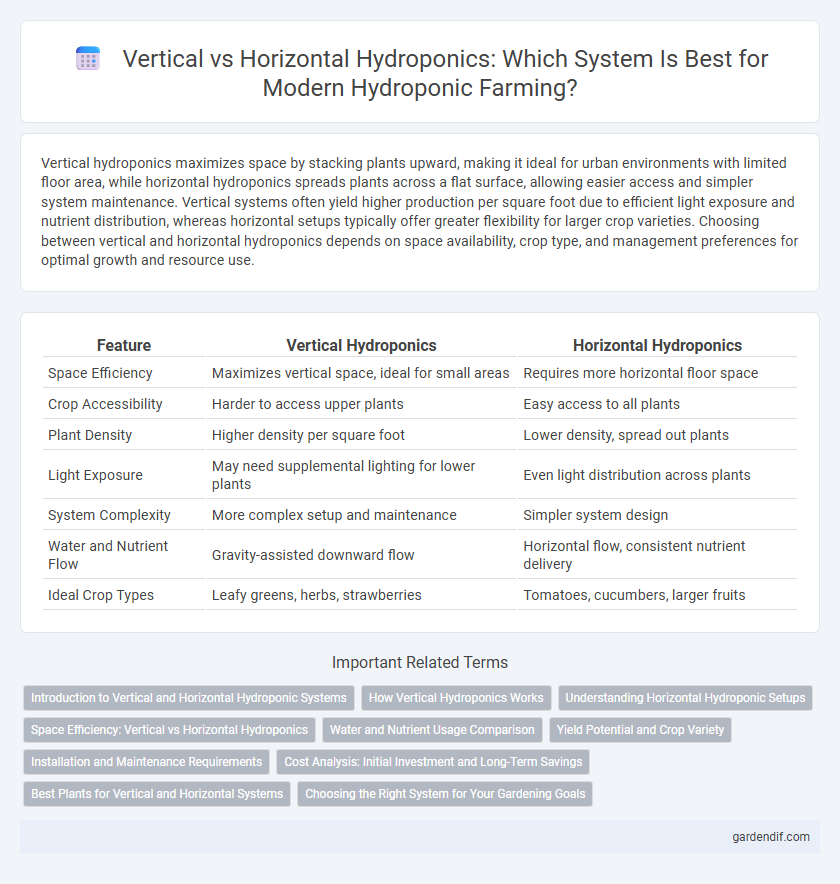
Vertical Hydroponics vs Horizontal Hydroponics Illustration
Vertical hydroponics maximizes space by stacking plants upward, making it ideal for urban environments with limited floor area, while horizontal hydroponics spreads plants across a flat surface, allowing easier access and simpler system maintenance. Vertical systems often yield higher production per square foot due to efficient light exposure and nutrient distribution, whereas horizontal setups typically offer greater flexibility for larger crop varieties. Choosing between vertical and horizontal hydroponics depends on space availability, crop type, and management preferences for optimal growth and resource use.
Table of Comparison
| Feature | Vertical Hydroponics | Horizontal Hydroponics |
|---|---|---|
| Space Efficiency | Maximizes vertical space, ideal for small areas | Requires more horizontal floor space |
| Crop Accessibility | Harder to access upper plants | Easy access to all plants |
| Plant Density | Higher density per square foot | Lower density, spread out plants |
| Light Exposure | May need supplemental lighting for lower plants | Even light distribution across plants |
| System Complexity | More complex setup and maintenance | Simpler system design |
| Water and Nutrient Flow | Gravity-assisted downward flow | Horizontal flow, consistent nutrient delivery |
| Ideal Crop Types | Leafy greens, herbs, strawberries | Tomatoes, cucumbers, larger fruits |
Introduction to Vertical and Horizontal Hydroponic Systems
Vertical hydroponic systems maximize space by stacking plant channels or towers, making them ideal for urban farming and limited areas. Horizontal hydroponics arranges plants side by side on flat surfaces, offering easier maintenance and uniform light exposure for each crop. Both systems efficiently use water and nutrients but differ in spatial design and scalability for various agricultural needs.
How Vertical Hydroponics Works
Vertical hydroponics works by stacking multiple layers of plant-growing channels or towers vertically, allowing plants to receive nutrient-rich water through a recirculating system. This method maximizes space efficiency by utilizing vertical surfaces, enhancing light exposure and air circulation. Nutrient solutions flow downward through each layer, ensuring roots absorb essential minerals while conserving water and nutrients.
Understanding Horizontal Hydroponic Setups
Horizontal hydroponic setups arrange plants in a single, flat plane, maximizing light exposure and facilitating ease of access for maintenance and harvesting. This method optimizes nutrient delivery through evenly distributed channels that support steady water flow and root aeration. Compared to vertical systems, horizontal setups often require less structural support and are ideal for crops with wider spacing needs, enhancing growth efficiency.
Space Efficiency: Vertical vs Horizontal Hydroponics
Vertical hydroponics maximizes space by stacking multiple growing layers vertically, allowing cultivation in limited areas such as urban rooftops or small indoor rooms. Horizontal hydroponics requires more surface area since plants are arranged side by side, making it less suitable for environments where floor space is constrained. Vertical systems optimize space efficiency by increasing plant density without expanding footprint, boosting yield per square foot.
Water and Nutrient Usage Comparison
Vertical hydroponics maximizes water efficiency by recycling nutrient solutions through stacked growing layers, reducing overall water consumption compared to horizontal systems. Horizontal hydroponics typically require more water volume to maintain uniform nutrient distribution across wider, flat grow beds. Studies indicate vertical setups can use up to 70% less water while delivering equal or higher nutrient uptake efficiency due to gravity-assisted flow and longer root exposure.
Yield Potential and Crop Variety
Vertical hydroponics systems maximize yield potential by utilizing stacked layers, allowing more plants to grow per square foot compared to horizontal setups. These systems are ideal for leafy greens, herbs, and vine crops, supporting higher crop variety within limited space. Horizontal hydroponics offer simpler management and are better suited for larger plants like tomatoes and cucumbers but typically yield less per unit area than vertical counterparts.
Installation and Maintenance Requirements
Vertical hydroponics systems require strategic installation to maximize space efficiency, often involving sturdy support structures and precise nutrient delivery setups to ensure uniform plant growth. Maintenance focuses on monitoring water flow and nutrient distribution across multiple stacked layers to prevent clogging and ensure even root hydration. Horizontal hydroponics, by contrast, feature simpler installation with plants arranged in a single plane, easing access for routine cleaning and nutrient adjustments but occupying more floor space.
Cost Analysis: Initial Investment and Long-Term Savings
Vertical hydroponics systems typically require higher initial investments due to the need for specialized structures, pumps, and lighting arrangements, but they optimize space usage and increase yield per square foot, resulting in significant long-term savings. Horizontal hydroponics generally involves lower startup costs with simpler setup and easier maintenance, though they demand more space and may produce lower yields, potentially increasing operational expenses over time. Cost analysis shows vertical systems offer better scalability and efficiency, making them more cost-effective for commercial growers aiming for high productivity and resource optimization.
Best Plants for Vertical and Horizontal Systems
Vertical hydroponic systems excel with vining or climbing plants like tomatoes, cucumbers, and strawberries, which maximize vertical space and light exposure. In contrast, horizontal hydroponics suits leafy greens such as lettuce, spinach, and kale, providing ample surface area for uniform growth and easier maintenance. Selecting crops based on system orientation enhances yield efficiency and plant health in hydroponic cultivation.
Choosing the Right System for Your Gardening Goals
Vertical hydroponics maximizes space efficiency by stacking plants vertically, ideal for urban gardeners with limited areas looking to optimize yield per square foot. Horizontal hydroponics spreads plants on a single plane, enabling easier access and maintenance, better suited for beginners or those managing larger plots with ample room. Selecting the right system depends on available space, crop type, and desired scalability to ensure optimal growth and resource use.
Vertical Hydroponics vs Horizontal Hydroponics Infographic

 gardendif.com
gardendif.com